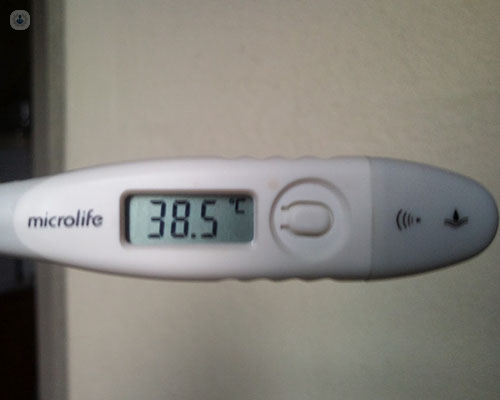Fever of unknown origin
Dr Abbi Lulsegged - Endocrinology, diabetes & metabolism
Created on: 01-14-2014
Updated on: 09-20-2023
Edited by: Aoife Maguire
What is fever of unknown origin (FUO)?
A fever of unknown origin (FUO) is a fever of at least 38.3°C, which lasts for more than three weeks or occurs often without explanation.

What are the different types of fever of unknown origin?
There are four classifications of fever of unknown origin:
1. Classic FUO – this is an unexplained fever that lasts for three weeks. Infections or neoplasms such as leukaemia may be the cause. Other disorders that can affect connective tissue may also be the cause.
2. Nosocomial – people usually get a fever due as a result of hospitalisation after being admitted for something other than fever and then being to run to the unexplained fever. The common causes include pulmonary embolism, sinusitis, deep vein thrombosis and septic thrombophlebitis (an inflammation that affects the veins).
3. Immune-deficient – this occurs in people with compromised immune systems and means that they are at increased risk of infection. A compromised immune system usually occurs following chemotherapy treatment.
4. HIV – the disease itself can cause fevers and also makes people more likely to catch infections that can cause fevers.
What are the symptoms?
Typical symptoms of fever of unknown origin include:
- A temperature over 38.3°C in adults or 37.5°C in children
- Sweating
- Chills
- Headaches
- Body or joint aches
- Fatigue
- Rash
- Cough and sore throat
How is FUO diagnosed?
A fever has to last long enough to be classified as FUO. Firstly, the doctor will ask the patient if they have been out of the country, had any environmental exposures or changed their daily environment. They will also ask about the patient’s family history of illnesses such as lymphoma. Blood work and physical examinations are carried out as blood tests can check for certain conditions, whilst the skin is examined for signs of rash or jaundice. Blood, urine and sputum cultures are checked for causes such as bacteria and fungi. If the doctor hears a murmur or suspects endocarditis, then an imaging test may be required to evaluate the heart. Chest X-rays may be required to check the lungs.
Treatment of FUO
The treatment of fever of unknown origin depends on the cause. In cases where there is no trace of an underlying cause, non-steroidal anti-inflammatory drugs and antihistamines may be used as these medications help to reduce the fever. People whose fevers originate from immune-deficiency may be treated with broad-spectrum antibiotics. Infections are responsible for between 20-40 per cent of FUO. Those with HIV-associated fevers and treated with antiviral drugs.


